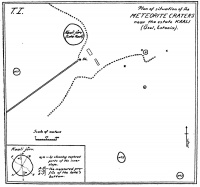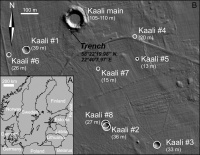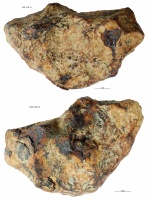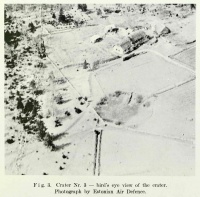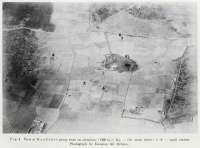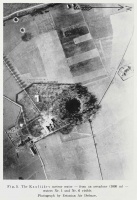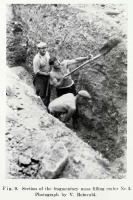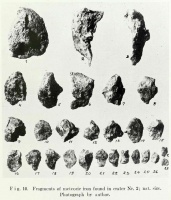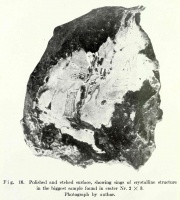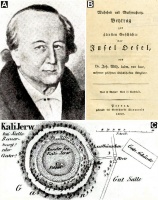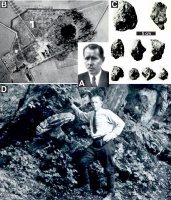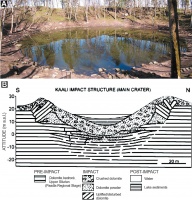(Unless otherwise stated, the copyright of the materials included belong to Jan Woreczko & Wadi.)
Kaalijarv
Z Wiki.Meteoritica.pl
| Strona w budowie (Site under construction) Jeszcze to chwilę potrwa (It will take a while) |
Znaleziono tylko kilkaset małych fragmentów... czy aby na pewno?
| Kaalijarv → | |
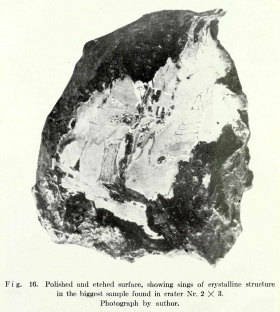
| |
| Znalezisko | |
| Lokalizacja | Estonia |
| Położenie[1] | 58°24'N, 22°40'E |
| Data | 1937 |
| Uwagi | meteoryty znajdowane są w okolicach grupy kraterów Kaalijärv |
| Charakterystyka | |
| Typ | żelazny, oktaedryt gruboziarnisty Og, IAB-MG |
| Masa | ~2,25 kg |
| Liczba okazów | setki małych zwietrzałych fragmentów |
| Meteoritical Bulletin Database | |
| Synonimy → | |
| wg NHM Cat: Kaali, Sall | |
Porównanie składu meteorytu Morasko z innymi meteorytami z grupy IAB-MG (Og) (źródło: Choi et al. 1995 i inne; zobacz również → Woźniak (2021, ASMP)):

Meteoryt/
/pierwiastekMorasko Campo
del Cielo[2]Canyon
Diablo[3]Magura Odessa
(iron)[4]Kaalijarv‡ Ni [%] 6,85 7,13 7,01 6,48 7,19 7,53 i 7,55 Co [%] 0,454 0,437 0,466 0,462 0,471 0,481 i 0,47 Ga [ppm] 103,6 91 81,8 98,2 75,6 82,1 i 78,2 Ge [ppm] 496 392 327 483 283 311 Ir [ppm] 1,1 3,19 2,32 3,6 2,4 3,07 i 3,0 Pt [ppm] 9,7* 6,7 6,2 – 6,2 8 i <3,6 Cu [ppm] 158 136 152 142 130 165 i 153 Cr [ppm] 25 40 25 26 33 28 i 17 Au [ppm] 1,52 1,48 1,56 1,53 1,65 1,712 i 1,641 W [ppm] 1,74 1,32 1,11 1,80 1,27 1,0 i 0,87 As [ppm] 10,9 10,8 13,1 10,5 14,4 17 i 18
- * wartości z pracy Pilski et al. (2013, MaPS);
- ** ppm (ang. parts per million) – części na milion;
- † wyniki analiz innej próbki.
- ‡ źródło: Wasson et al. (2002)
Kolekcje
Meteoryt Kaalijarv w największych kolekcjach:
Zbiór waga fragmentów
(Koblitz MetBase)uwagi Tallinn, Geol. Inst. Acad. Sci. 3,59 kg największy fragment 28,2 g Moscow, Acad. Sci. 88,5 g największy fragment 22 g Minsk, Geol. Mus. 15 g London, Nat. Hist. Mus. 14,6 g New York, Amer. Mus. Nat. Hist. 9 g (…)
Kratery
Dane kraterów Kaalijärv krater średnica/
/głębokość
[m]opis Main 105-110 największy; stale wypełniony wodą 1 39 2 36 nakłada się na krater 8 3 33 4 20 zniszczony, słabo widoczny 5 13 6 26 zniszczony, słabo widoczny 7 15 zniszczony, słabo widoczny 8 27
Lokalizacja
(K) Kaali
Rozmieszczenie kraterów
Kaali Meteoritics and Limestone Museum
* W 2018 roku Google zmieniło zasady działania apletu, mapa może wyświetlać się niepoprawnie (pomaga Ctrl+F5); więcej → Szablon:GEMap-MyWiki
Galerie
Grupa kraterów Kaalijärv
Współcześnie znalezione okazy (źródło: Geoscience collections of Estonia)
Okaz meteorytu Kaalijarv (172,2 g, nazwany „Maria“) ze zbiorów Uniwersytetu w Tartu (University of Tartu) |
Okaz meteorytu Kaalijarv (620,96 g, nazwany „Mateusz“) ze zbiorów Uniwersytetu w Tartu (University of Tartu) |
Wybrane ilustracje z publikacji Reinvald (1940)
Wybrane ilustracje z publikacji Racki et al. (2018) opisującej historię odkrycia kraterów i ich badań (z oryginalnymi podpisami)
Fig. 3. A. Johann Wilhelm Ludwig von Luce (1750–1842), the German priest and scholar, engaged in propagation of Estonian language, who first described the Kaali lake crater in 1827 (https://utlib.ut.ee/eeva/index.php?lang=de&do=autor_pilt&aid=85&eid=37). B. Title page of his work on the Oesel Island, containing first account on the crateriform structure. C. The oldest location plan of the Kaalijärv crateriform structure published in an archaeological monograph of Kruse (1842, pl. 62), who probably introduced this name (as KaliJerw) to scientific literature (Wangenheim von Qualen, 1849, p. 36). |
Fig. 4. First geological cross sections and schematic plan of the Kaalijärv crateriform structure, published by Wangenheim von Qualen (1849, pl. 5 in the Moscow edition; A) and Eichwald (1854, p. 8; B1), as a visualization of two opposing endogenic models, maartype volcanic and sinkhole, respectively (compare with later graphical elucidation of the crater as the meteorite impact site – Figs. 2B and 5C, D). In the hypothesized ground collapse, “A” means a funnel-like depression, “þ” – the layers of limestone at the lake are subsided, they are strongly bent and broken and they show the layers at the wall “a” from it downfallen position, almost as at “b” where “þ” means that there has been similar downwashing of clay layers between the limestone layers. It shows directly that there is a subterranean connection between the lake and the spring at Salla. |
Fig. 7. Ivan A. Reinwald (A; https://www.geni.com/people/Ivan-Reinwald/6000000052529043831), inspector of the Mining Industry of Estonia, leading researcher of the Kaali crater field since 1927, and the principal impact characters documented by him: tilted dolomite strata in the upper part of the interior wall of the Kaali crater (cf. with Fig. 6), with Reinwald in the foreground (B); shattered meteoritic iron pieces from craters no. 2 and 5 (C), and Kaalijärv viewed from aeroplane of Estonian Air Defense in 1938 (D); from Fisher (1936, p. 298; B) and Reinwald (1940, C – compiled from figs. 10 and 14; D – fig. 5, cf. with Fig. 2A). |
Bibliografia
- Aaloe Aasa O. (Аалоэ Ааза), Нестор Хелдур Эдуардович (Nestor Kheldur Eduardovich), (1963), Метеориты коллекции Института геологии Академии наук Эстонской ССР (The Meteorite Collection of the Institute of Geology, Academy of Sciences of the Estonian S.S.R.), Метеоритика (Доклады на расширенном пленуме комитета по метеоритам Академии наук Эстонской ССР), Sari: Eesti NSV Teaduste Akadeemia Geoloogia Instituudi uurimused XI, Eesti Teaduste Akadeemia Geoloogia Instituut, Tallinn 1963, s. 121-132.[5]
- Buchwald Vagn Fabritius, (1975), Handbook of Iron Meteorites. Their History, Distribution, Composition, and Structure, University of California Press, Berkeley 1975, (s. 704). ISBN 0-520-02934-8.[6] Pliki PDF.
- Koblitz Jörn, MetBase. Meteorite Data Retrieval Software, Version 7.3 (CD-ROM), Ritterhude, Germany 1994-2012. MetBase.
- Łosiak Anna, Wild Eva M., Geppert Wolf D., Huber Matthew S., Jõeleht Argo, Kriiska Aivar, Kulkov Alexander, Paavel Kristiina, Pirkovic Irena, Plado Jüri, Steier Peter, Välja Rudolf, Wilk Jakob, Wisniowski Tomek, Zanetti Michael, (2016), Dating a small impact crater: An age of Kaali crater (Estonia) based on charcoal emplaced within proximal ejecta, Meteoritics & Planetary Science, vol. 51(4), 2016, s. 681-695.[7] Plik doi.
- Łosiak Anna, Jõeleht Argo, Plado Jüri, Szyszka Mateusz, Kirsimäe Kalle, Wild Eva M., Steier Peter, Belcher Claire, Jaźwa Aleksandra M., Helde E., (2020), Determining the age and possibility for an extraterrestrial impact formation mechanism of the Ilumetsä structures (Estonia), Meteoritics & Planetary Science, vol. 55(2), 2020, s. 274-293.[8][7] Plik doi.
- +Martin Imre Andreas, (2019), Kaali raudmeteoriidi petrograafiline ja geokeemiline kirjeldus, Geoloogia osakonna bakalaureusetööd – Bachelor's theses, Tartu 2019, ss. 34.[9] Plik PDF.
- Plado Jüri, (2012), Meteorite impact craters and possibly impact-related structures in Estonia, Meteoritics & Planetary Science, vol. 47(10), 2012, s. 1590-1605. Plik doi.
- +Plado Jüri, (2019), Meteoorist kraatrini, Argo 2019, ss. 176 (po estońsku). ISBN: 978-9949-607-82-2.
- +Racki Grzegorz, Viik Tõnu, Puura Väino, (2018), Julius Kaljuvee, Ivan Reinwald, and Estonian pioneering ideas on meteorite impacts and cosmic neocatastrophism in the early 20th century, Bulletin de la Société Géologique de France, 189(11), 2018, ss. 20. Plik doi.
- Reinvaldt (Reinwald) J.(Ivan) A., (1933)[10], Kaali järv - The meteorite craters on the island of Ösel (Estonia), Tartu Ülikooli juures oleva Loodusuurijate Seltsi Aruanded, 39, Tartu 1933, s. 183-202. Plik PDF.
- Reinvald Ivan A., (1940)[10], The Kaalijärv meteor craters (Estonia). Supplementary research of 1937: Discovery of meteoritic iron, Tartu Ülikooli juures oleva Loodusuurijate Seltsi Aruanded, 45, Tartu 1940, s. 81-99. Plik PDF.
- Stankowski Wojciech, Raukas Anto, Bluszcz Andrzej, Fedorowicz Stanisław, (2007), Luminescence dating of the Morasko (Poland), Kaali, Ilumetsa and Tsõõrikmäe (Estonia) meteorite craters, Geochronometria, 28, 2007, s. 25-29.[8][11] Plik doi.
- Stankowski Wojciech, (2009), Nowe dane luminescencyjne wieku impaktów w Morasku oraz Kaali (The new luminescence data of the Morasko and Kaali impacts), Acta Soc. Metheor. Polon., 1, 2009, s. 123-128. Plik PDF; plik ASMP.
- Tiirmaa Reet (Тийрмаа Р.Т.), (1983), Каталог метеоритов коллекции Института геологии АН ЭССР на октября 1981 г. (The catalog of meteorites from the collection of the Geological Institute of the Estonian Academy of Sciences on October 1, 1981), Метеоритика (Meteoritika), vol. 42, 1983, s. 170-182.[12]
- Tiirmaa Reet, (1994), Kolekcja meteorytów Instytutu Geologicznego Estońskiej Akademii Nauk, Meteoryt, 1, 1994, s. 6-10 (tłum. Michał Kosmulski).[13] Plik PDF.
- Uścinowicz Grzegorz, (2014), Impact craters and the extraterrestrial matter in their surroundings: case of Morasko (Poland) and Kaali (Estonia), Baltica: The International Journal on Geosciences, 27(1), 2014, s. 25-32. Plik doi.
- Wasson John T., Kallemeyn Gregory W., (2002), The IAB iron-meteorite complex: A group, five subgroups, numerous grouplets, closely related, mainly formed by crystal segregation in rapidly cooling melts, Geochimica et Cosmochimica Acta, 66(13), 2002, s. 2445-2473. Plik doi; plik PDF.
- Явнель Александр Александрович, Иванов Андрей Валерьевич, Заславская Н.И. (Yavnel' A.A., Ivanov A.V., Zaslavskaya N.I.) (1986), Каталог метеоритов коллекций Советского Союза (Catalogue of meteorites of collections of the USSR), Ротапринт ГЕОХИ АН СССР, 1986, ss. 221.[14][15] Zbiory własne W&W.[16]
- Zhu M.-H., Bronikowska M., Łosiak A., (2016), The formation of Kaali crater, Estonia: insights from numerical modeling, 79th Annual Meeting of The Meteoritical Society, Berlin, Germany, 2016.[17] Abstract [#6325].
- Pełna literatura na temat, na portalu Geoscience collections of Estonia.
Przypisy
Zobacz również
Linki zewnętrzne
- Meteoritical Bulletin Database (MBD) – meteoryt Kaalijarv
- Encyclopedia of Meteorites (EoM) – meteoryt Kaalijarv
- Meteoritical Bulletin Database (MBD) – meteoryt Kaalijärv [crater]
- Uniwersytet w Tartu, Estonia (University of Tartu, Estonia; Tallinn, Geol. Inst. Acad. Sci.) – Tartu Ülikool, Eesti ● Tartu Ülikooli loodusmuuseum ja botaanikaaed – Natural History Museum and Botanical Garden ● Geoscience collections of Estonia (search meteorite) ● [katalogi → Levinson-Lessing (1897); Tiirmaa (1983); Tiirmaa (1994)]
